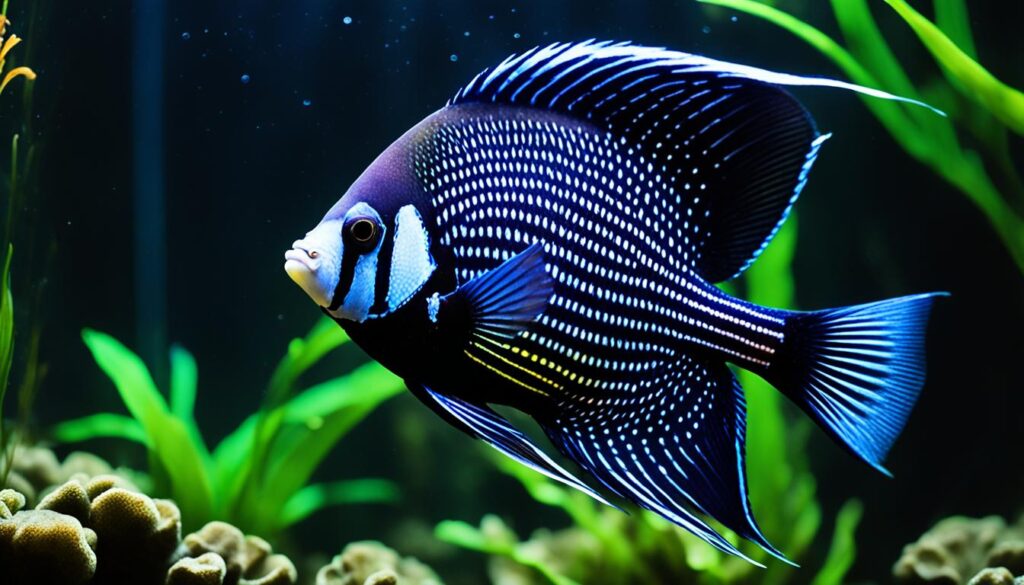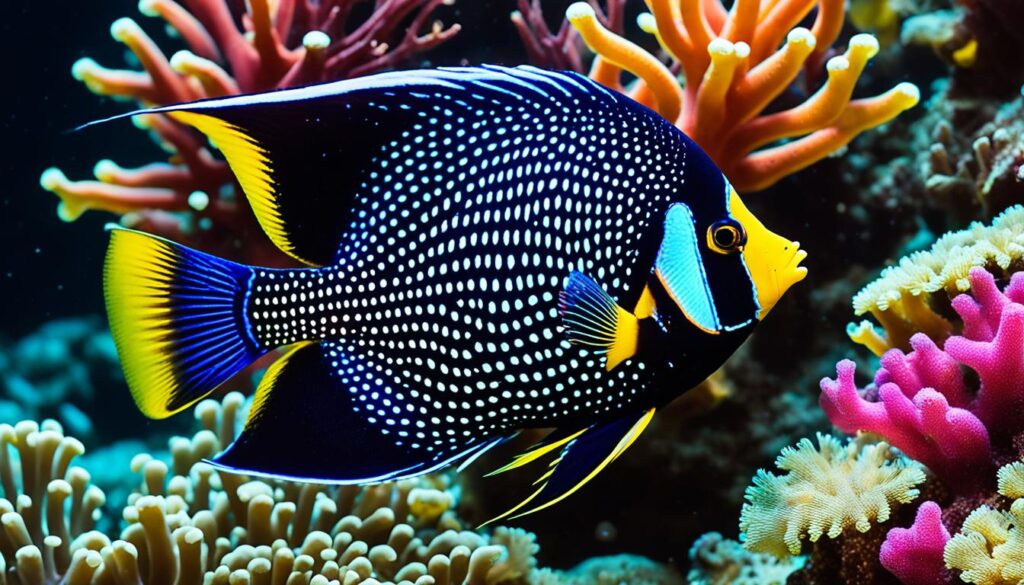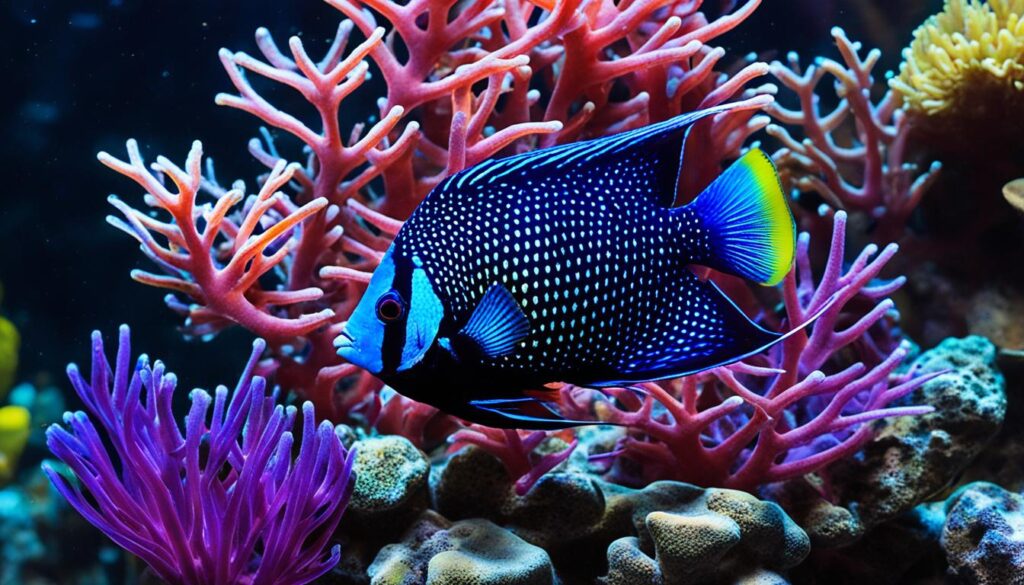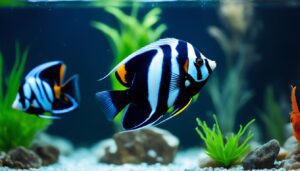The first time I saw the Midnight Angelfish, also called the Centropyge nox or Black Velvet Angelfish, I was struck. Its sleek, all-black body stood out. It’s more than just any marine aquarium fish; the Black Nox Angelfish grabs your attention with its mysterious charm.
I’ve found these saltwater aquarium species are tough, which is great for both experienced and new marine enthusiasts. They need a big tank, at least 70 gallons, to thrive and let a pecking order develop with other fish.
In my time keeping these unique fish, I’ve noticed they are mostly peaceful. But they can get feisty around other angelfish. They eat special food like spirulina and marine algae, plus extra treats like mysis and brine shrimp three times a day.
Future owners of Midnight Angelfish should remember they can live over ten amazing years with the right care. When thinking about tank mates, keep in mind they might snack on some soft corals and invertebrates. But with the right friends, they can be a calm and nice part of your aquarium world.
Midnight Angelfish (Centropyge Nox) Species Profile

Welcome to an interesting look at the Midnight Angelfish (Centropyge Nox). They are a beautiful example of saltwater angelfish found in Pacific Ocean reef fish habitats. These angelfish catch the eye and spark interest among aquarists and marine biologists alike with their unique Centropyge nox profile.
The Midnight Angelfish stands out with its sleek, dark body. It lives among coral slopes and lagoons in the Pacific Ocean. These creatures show incredible adaptability, proving they’re special in the saltwater aquarium world.
These angelfish usually prefer to be alone in the wild. They don’t swim in schools. They eat various algae and microfauna. This diet helps keep their colors bright and keeps them healthy in tanks.
Characteristic |
Details |
|---|---|
Max Length |
10.0 cm TL male/unsexed |
Dorsal Spines |
14 – 15 |
Dorsal Soft Rays |
16 – 17 |
Anal Spines |
3 |
Anal Soft Rays |
16 – 17 |
Preferred Temperature |
26.3 – 29°C |
Trophic Level |
2.8 ±0.29 se |
Resilience |
Medium, 1.4 – 4.4 years |
Fishing Vulnerability |
Low (10 of 100) |
Knowing these details is key to caring for Midnight Angelfish in tanks. If you’re thinking of getting one, these facts will help you set up the best environment. You want to make sure your new Pacific Ocean reef fish thrives.
Distinctive Habitat and Range

The Midnight Angelfish, known as Centropyge nox, finds its home in complex, beautiful places. This section looks at the unique areas these fish live in. It also covers their wide range across the world’s tropical waters.
Rocky Reefs and Lagoons
The Midnight Angelfish natural habitat is among rocky reefs and lagoons. These spots offer shelter and food, which they need to survive. The water here is full of corals and many kinds of life, including Centropyge nox.
They love living among the reefs. This shows how vital reef areas are for many marine species.
Geographic Distribution: From Japan to the Great Barrier Reef
The Centropyge nox distribution is wide, showing they can live in many sea areas. They are found from Japan’s waters to the coral reefs in Indonesia, and all the way to Australia’s Great Barrier Reef. This wide range points out their love for salty waters and their strength in different reef ecosystems in the Indo-Pacific.
Midnight Angelfish’s Size, Lifespan, and Diet

Welcome to the fascinating world of the Midnight Angelfish. This species is known for its beautiful look and small size. It has a long lifespan and needs a special diet. Let’s learn more about these important facts.
A Compact Size with a Notable Lifespan
The Midnight Angelfish usually grows up to 4.7 inches. It’s one of the smaller angelfish types. This size is perfect for small saltwater aquariums where you don’t have much room. Even though it’s small, the angelfish can live for more than ten years with good care.
Nutritional Requirements in Captivity
The diet of the Midnight Angelfish is key for its health and color. In the wild, they eat algae and tiny sea creatures. In tanks, they need fresh and dry algae for a well-rounded diet. Adding mysis shrimp and shaved shrimp makes their diet even better.
It’s good to feed the Midnight Angelfish several times a day. This is similar to how they would eat in the ocean. Also, it’s important to give them food made for algae-eaters, like flake or pellet feed. This ensures they get everything they need for their health and long life.
Knowing what the Midnight Angelfish needs is crucial for keeping them well. A balanced diet and the right tank conditions can make these fish thrive. With care, these angelfish can add beauty and calm to your aquarium for many years.
Tank Setup and Care for Optimal Health

Creating the right home for the Midnight Angelfish is key to their wellbeing. It’s essential to meet the Midnight Angelfish tank requirements. A perfect aquarium setup for Centropyge nox mimics their natural environment. This helps them thrive instead of just survive.
A 70-gallon tank is the minimal size recommended to make the fish comfortable. Since Midnight Angelfish don’t do well with coral reefs, think about using live rock instead. Live rock not only filters the water but also provides food like algae and small crustaceans.
Keep the water in the best condition with a pH level of 8.1 to 8.4 and salinity between 1.020 and 1.025. The temperature should be kept between 74°F to 78°F. These settings make a safe and stress-free home for the fish, helping them stay healthy.
Parameter |
Value |
|---|---|
Minimum Tank Size |
70 Gallons |
pH Level |
8.1-8.4 |
Salinity |
1.020-1.025 |
Temperature |
74°F – 78°F |
Feeding your Midnight Angelfish should include Spirulina, marine algae, mysis shrimp, and quality meaty foods. Feed them three times daily to avoid overfeeding. This keeps their colors bright and supports their health.
Marine fishkeeping is enjoyable and fulfilling. However, ensure your fish comfortably settle into their new home. Introduce the Midnight Angelfish to your tank slowly, over three hours, to avoid shock. This care reduces the risks they face when they first arrive.
Focus on these aquarium setup for Centropyge nox tips to help your Midnight Angelfish excel. A content and healthy fish thrives, so start off right. A bit of effort will make a huge difference.
Behavioral Traits and Compatibility
Over the years, I’ve learned a lot about Midnight Angelfish. They are generally peaceful fish. They add beauty and calm to a saltwater community tank. But, they do have their unique behaviors and needs, especially when living with other fish.
Midnight Angelfish are okay with certain corals and invertebrates. Yet, they can become territorial. Having many hiding places helps decrease this. Adding new fish carefully helps them get along better. I choose calm fish like Guppy Fish and Neon Tetras as their tank mates. This avoids stress. Giving them a variety of good food also keeps them from bothering other fish.
Breeding these fish needs a bit of attention to size. Often the bigger one becomes the male. Their breeding gives us a peek into their care for their young. These fish can live up to 10 years with proper care. This includes keeping the water clean and at the right temperature and pH. Watching for sickness signs and treating them is key to their health.








